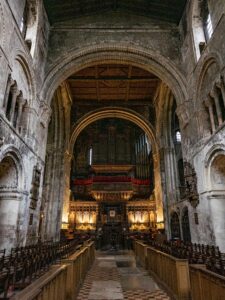 Ghosts…it’s an emotive topic. To believe or not to believe…that is the question!
Ghosts…it’s an emotive topic. To believe or not to believe…that is the question!
The City of London is said to have many haunted places, which is no surprise really with a history spanning thousands of years. In fact, the earliest evidence of life in London was the discovery of a flint tool found in Vauxhall that dates back to before 10,000 BC.
London has seen many historic events and some gruesome ones too…all leading to tales ofhauntings. Today, we are investigating the claim of the most haunted church in the City ofLondon: St Bartholomew the Great. There are many stories of ghostly apparitions, strange visitations and physical encounters. So, let’s begin with a look more closely at the history of the church and the building itself.
The History
St Bartholomew the Great is the oldest surviving parish church in the City of London. It has been in continuous use since 1123. The oldest part of the church has survived the Reformation, the Great Fire of London and the Blitz in WW2.,For the story of St Bartholomew’s origins, you need to be introduced to someone without whom, the church would not be in existence, a man called Rahere.
Rahere was born into humble beginnings in the early 12th century. Not much is documented about his early life but it has been said that in his youth he flourished and charmed his way into more noble households, ending up in the court of Henry I. All manner of vocations have been bestowed on him, most commonly as a minstrel or court musician, and court jester, due to his wit and charm. He is also said to have been a politician. While there are no official records of his employment in the king’s court, eyewitness accounts place him there. We do know one official fact – that he was a canon at St Paul’s Cathedral. Sadly, King Henry lost his wife Queen Matilda in 1118 and his son and heir, William two years later, which left him grief stricken. So, if Rahere was a court jester, then that was not the best place for him to be, and he embarked on a pilgrimage to Rome. Whilst there he fell desperately ill and St Bartholomew appeared to him in a vision urging him to build a church and hospital at Smithfield (known back then as smooth fields). Rahere recovered, travelled back to England with enthusiasm at his new calling, and went to see King Henry with his very specific request. Henry, pleased at Rahere’s return, granted him land at Smithfield on which Rahere built the church and the hospital next door.
The Building
The church was founded as an Augustinian priory with a hospital in the grounds. You can still see the remains of one side of the original cloisters. Inside the church, the crossing and the choir are original. They have been described as ‘a rare sight in London: indeed, Great St Bart’s is reckoned to be the best preserved and finest Romanesque church interior in the city’. The reason the rest of the building (including most of the exterior) has altered so much is due to the Reformation. Henry VIII gave St Bartholomew’s to his wily minister, Richard Rich, who set about dismantling it immediately. The reason so much of the original priory remains is mainly due to a group of plucky parishioners who petitioned Richard Rich for the remainder of the building to be left intact so they could continue to worship there. While there have been alterations to the exterior (the tower was constructed in the 17th century) – the church which started life as a catholic priory is today a parish church for the Church of England and celebrated its 900th birthday two years ago.
The Ghostly Sightings
So, how did St Bartholomew the Great gain the title of most haunted church in the City? To me, as a sceptic it all sounds a bit far-fetched, but visitors have reported seeing apparitions, feeling sudden temperature changes, sensing a strong ‘presence’ beside them and a ghostly figure walking about the church – most frequently in the Lady Chapel. Enthusiasts suggest that the spirit belongs to that of the founder, Rahere…. but why?
During renovations in the 19th century, there was some concern regarding Rahere’s tomb – and whether the founder’s remains were facing the ‘right way’. It is the custom for Catholic priests to be buried facing west. This follows the belief that when the dead rise on the Day of Judgement, the clergy would face their congregation ready to lead them again. So, to check which way Rahere was facing, builders opened the rear of the tomb, and shamelessly stole one of his feet along with the sandal he was wearing. The sandal was later found and returned to the tomb – minus the foot. So, it said that Rahere is constantly roaming the interior of the church looking for his foot!
Maybe after reading this you will want to go see for yourself whether you can witness any ghostly activity. Or you may just want to visit the church to bask in its majesty. If you need any more convincing, you can also see one of only two pre-Reformation fonts left in the City of London. You can also see the thought-provoking masterpiece by Damien Hirst entitled Exquisite Pain – a sculpture of St Bartholomew in his martyred form having been flayed alive. There is also Prior Bolton’s Oriel window – an internal window high above the nave designed to allow the prior to keep an eye on his monks and make sure they were not up to mischief!
And should any reader experience a ghostly encounter please let us know!
